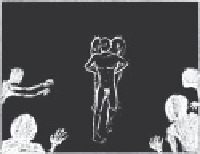Graphics Reference
In-Depth Information
Then it comes. A production meeting. We see the designs and meet the designer producer and director,
we know them all, we've known them all for years and this makes life easier. As usual 'can they have
prices ASAP', even though everything will change before we start the build. We scratch our heads and
pore over the designs; how do you price up a forest, how big is it, how many trees make a forest? It could
be any size and please why can't they cut it please?
Work starts and for a while all is well; this is the best bit (apart from getting the cheque at the end).
A day later it turns into a nightmare, deadlines creep closer, freelancers are unavailable, the sets have
unaccountably got bigger since the quote and it'll never get done on time. I don't actually know why
I worry. It always gets done on time.
Each set is fi nished, approved, changed, approved again and goes out. Now the magic happens as it goes
through several transformations. It looks great when it leaves us, then it's propped and dressed and looks
even better. The lighting cameraman waves his magic wand and it starts to come alive. Puppets next and
then the real heroes, the dollywagglers, complete the transformation from wood and canvas (actually
MDF, glass fi bre and artex) to a living, breathing world.
Surely it must give you great pleasure and pride to see your work on TV. No. It goes out at some
unearthly hour for the kiddies, while we're at work; and if we have no work we're too busy worrying
about the lack of work to watch TV.
For the ovarian cysts, we cut the fi ngertips from latex gloves fi lled them with KY Jelly, tied a knot in the
end, painted them with liquid latex coloured blood red, left them to dry a bit, then rolled them about a bit
to mess up the latex so it looked like fl eshy tissue, and popped them in the post.
Props
Since most animation i lms feature less than human characters existing in some sort of
recognisable variation of a human context there's always bound to be interesting conl ict when
a character has to act in a human way. In
The Wind in the Willows
, Ratty played a seemingly
endless ditty on the piano, called 'We'll go boating. When faced with such things I jump in
and take this as an excuse to learn the piece precisely - can there be such a thing as method
animation? The beautifully made piano had proportions more suitable to a realistic human, not
an Edwardian rat! If it had been, it might easily have lost its essential piano quality. Come the
weeks of i lming, I had to adapt the playing, as not only did Ratty not have enough i ngers to
play the notes exactly, but his girth meant that he had to sit close to reach the keyboard with
his short arms … so short that his belly got in the way of playing some of the notes. Add to
this the fact that his snout was so large that unless he turned or raised his head, he would have
pressed up against the music sheets. It is a great challenge to make this work. If I
couldn't play the exact notes, I could be overemphatic with the rhythm, which is
the storytelling part of playing a piano. Ratty had lovely supple wrists, i ngers and
thumbs, so I was able to make some rather delicate and precise wrist actions that
gave the impression of playing the piano exactly. Hopefully the audience were
watching the rhythm more than watching the notes the i ngers were playing. The
bar sheet looked a totally incomprehensible series of swoops and curves, but it



Search WWH ::

Custom Search